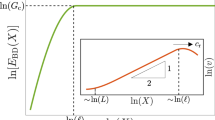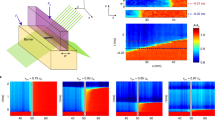Abstract
We consider rupture initiation and instability on a displacement-weakening interface. It is assumed to follow a power-law relation between a component of displacement discontinuity (whether tensile opening in mode I or shear slippage in modes II or III) and the reduction from peak strength of a corresponding component of stress (normal or shear stress) on the interface. That is, the stress decrease from peak strength, as the interface discontinuity develops, is assumed to be proportional to displacement-discontinuity to some exponent n > 0. The study is done in the 2D context of plane or anti-plane strain, for an initially coherent interface which is subjected to a locally peaked “loading” stress which increases quasi-statically in time. We seek to establish the instability point, when no further quasi-static solution exists for growth of the ruptured zone along the interface, so that dynamic rupture ensues. We have previously addressed the case of linear displacement-weakening (n = 1), and proven the remarkable result that for an unbounded solid, the length of the displacement-weakening zone along the interface at instability is universal, in the sense of being independent of the detailed spatial distribution of the locally peaked loading stress. Present results show that such universality does not apply when n differs from 1. Also, if n < 2/3, there is no phase of initially quasi-static enlargement of the rupturing zone; instead instability will occur as soon as the maximum value of the loading stress reaches the peak strength. We first employ an energy approach to give a Rayleigh–Ritz approximation for the dependence of quasi-static rupture length and maximum displacement-discontinuity on the loading stress distribution of a quadratic form. Results, depending on curvature of the loading distribution, show that qualitative features of the displacement-discontinuity development are significantly controlled by n, with the transition noted at n = 2/3. Predictions of the simple energy approach are in reasonable quantitative agreement with full numerical solutions and give qualitative features correctly.
Similar content being viewed by others
References
Abercrombie RE, Rice JR (2005) Can observations of earthquake scaling constrain slip weakening?. Geophys J Int 162(2): 406–424. doi:10.1111/j.1365-246X.2005.02579.x
Ampuero JP, Rubin AM (2008) Earthquake nucleation on rate and state faults—aging and slip laws. J Geophys Res 113: B01302. doi:10.1029/2007JB005082
Bilby B, Eshelby JD (1968) Dislocations and the theory of fracture. In: Liebowitz H (eds) Fracture, an advanced treatise, vol. 1. Academic Press, New York, pp 99–182
Dieterich JH (1979) Modeling of rock friction—1 Experimental results and constitutive equations. J Geophys Res 84: 2161–2168
Dieterich JH (1986) A model for nucleation of earthquake slip. In: Das S, Boatwright J, Scholz CH (eds) Earthquake source mechanics, geophysical monograph 37 (Maurice Ewing volume 6), (Am Geophys Union, Washington, DC), pp 37–47
Dieterich JH (1992) Earthquake nucleation on faults with rate- and state dependent friction. Tectonophysics 211: 115–134
Dieterich JH, Kilgore BD (1996) Implications of fault constitutive properties for earthquake prediction. Proc Natl Acad Sci USA 93: 3787–3794
Lapusta N, Rice JR (2003) Nucleation and early seismic propagation of small and large events in a crustal earthquake model. J Geophys Res 108(B4): 2205. doi:10.1029/2001JB000793
Madariaga R (1976) Dynamics of an expanding circular fault. Bull Seismic Soc Am 66: 639–666
Noda H, Dunham EM, Rice JR (2009) Earthquake ruptures with thermal weakening and the operation of major faults at low overall stress levels. J Geophys Res 114: B07302. doi:10.1029/2008JB006143
Rice JR (1992) Dislocation nucleation from a crack tip: an analysis based on the Peierls concept. J Mech Phys Solids 40: 239–271
Rice JR, Beltz GE (1994) The activation energy for dislocation nucleation at a crack. J Mech Phys Solids 42: 333–360
Rice JR, Uenishi K (2002) Slip development and instability on a heterogeneously loaded fault with power-law slip-weakening. Eos Trans. AGU, 83(47), Fall Meet Suppl, Abstract S61E-06
Rubin AM, Ampuero J-P (2005) Earthquake nucleation on (aging) rate and state faults. J Geophys Res 110: B11312. doi:10.1029/2005JB003686
Ruina A (1983) Slip instability and state variable friction laws. J Geophys Res 88: 10,359–10,370
Tse ST, Rice JR (1986) Crustal earthquake instability in relation to the depth variation of frictional slip properties. J Geophys Res 91: 9452–9472
Uenishi K, Rice JR (2003) Universal nucleation length for slip-weakening rupture instability under nonuniform fault loading. J Geophys Res 108(B1): 2042. doi:10.1029/2001JB001681
Uenishi K, Rice JR (2004) Three-dimensional rupture instability of a slip-weakening fault under heterogeneous loading. Eos Trans. AGU, 85(46), Fall Meet Suppl, Abstract S13E-04
Uenishi K, Rice JR (2010) Three-dimensional rupture instability of a displacement-softening interface under heterogeneous loading (to be submitted)
Author information
Authors and Affiliations
Corresponding author
Additional information
Koji Uenishi—Formerly at Department of Earth and Planetary Sciences and School of Engineering and Applied Sciences, Harvard University.
Rights and permissions
About this article
Cite this article
Rice, J.R., Uenishi, K. Rupture nucleation on an interface with a power-law relation between stress and displacement discontinuity. Int J Fract 163, 1–13 (2010). https://doi.org/10.1007/s10704-010-9478-5
Received:
Accepted:
Published:
Issue Date:
DOI: https://doi.org/10.1007/s10704-010-9478-5




